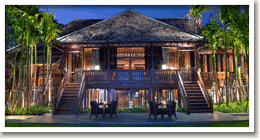





Recommended Attractions
Chiang Mai located in Northern Thailand possesses a range of magnificent temples that speaks volumes of the area’s history, culture and religion. Explore each of these temples that will take you through stunning courtyards and even offer you an opportunity to talk to some of the local monks. The city also comprises of a night bazaar and some restaurants and bars.
1. Three Kings Monument - Get a glimpse of the founders of Chiang Mai by visiting the Three Kings Monument located in the centre of a large courtyard. The statue of King Mangrai and his two colleagues is often frequented by devotees offering incense, flowers and candles to invoke their blessings. Head over during the morning and offer alms to the resident monks here.
2. Yuparaj Wittayalai School - Pay homage at this school which functions as a source of great learning and training for young Buddhist monks and caters especially to those who arrive from rural communities. The mid-morning hours would be perfect to witness a sea of orange-robed monks make their way to the Yuparaj Wittayalai School.
3. Wat Chiang Man (The Temple of the Fortified City) - Built after the founding of Chiang Mai in 1296, Wat Chiang Man is the oldest temple in the city. Depicting features of Lanna architecture, the temple houses the crystal Phra Satang Man and the marble Phra Sila which are Buddha statues believed to be over 2,000 years old. The Ordination Hall reveals enchanting wall paintings depicting the life of the Buddha.
4. Wat Hua Kuang (Wat Saen Muang Ma Luang) – From afar the 4-layered jagged roof of the Wat Hua Kuang will definitely stand out as you make your way down a bush-lined walkway. Feast your eyes on the grey elephant statues found by the side of the temple’s Ordination Hall. Clad in the royal dress, these statues differ from the white elephant statues that adorn other temples nearby.
5. Chang Puak (White Elephant Gate) - Witness the Old City Wall of Chiang Mai by arriving at the White Elephant Gate. Previously referred to as the Fortified Gates before being changed to its present name in 1400 AD, the gate is actually a replica of the original which was battered by the Japanese during the 2nd World War.
6. Wat Kun Kha Ma (Horse Temple)- One would find it hard to miss the peculiar wall that surrounds the temple for it is decorated in horse statues of various sizes made of solid gold. Upon entering the premises, you will be greeted by more statues of animals in the likes of the cow, rat and snake which resemble the symbols of the Chinese calendar.
7. Wat Ratchamontian (Dragon Temple)- A special feature of the temple are its large red spires that protrude from the wall surrounding it. The steep steps of the Dragon Temple will lead you past colourful dragons which guard the entrance. Walking through the maroon doors you would arrive at the upper section of the main temple where a magnificent Buddha statue will greet you.
8. Wat Lok Molee – Constructed during the mid 1300’s, the temple grounds were used as a Royal Palace until 1397. The large three tier brick Chedi and the ‘Ubosot’ or Ordination Hall were amongst those built by King Phra Muang Kaew. The main hall complex was erected in 2003 where two White Elephant statues and two demon warriors stand guard to ward off evil.
9. Janghuarinnakorn House – The imposing Janghuarinnakorn House is a three storey European style mansion found in the Northwest section of the Old City. This private residence is decorated in brightly-coloured stone accents and marble columns while one must not miss out on savouring views of the long rows of white statues that are found on an entire side of the mansion.
10. Hualin Corner Wall Section – Stroll along the section of wall that leads to the Hualin Corner. Encounter the worn out appearance that showcases its status before reconstruction took over in the 1970’s. Upon reaching the corner you will see a curved outcrop which will reveal evidence of an ancient watchtower that was once there.
11. Temple of the Lion Buddha (Wat Phra Singh) – In honour of King Kham Fu, the temple was built by King Phayu in 1345. The lion style Buddha statue regarded as the most sacred of its kind in the city was made a part of the temple and now sits proudly in the Sermon Hall. The Ho Trai Library possesses a collection Buddhist scripture which is worth a perusal.
12. Wat Tung Yu – The main Wihan here has a group of Naga guardians and gold doors that contribute towards its grandeur. A short distance away from the Wihan you are likely to come across a collection of statues where a golden parasol is flanked by a golden monk to its left and a silver monk to its right.
13. Wat Chaiprakiat – The local phrase ‘Chai Phra Kiat’ is used to describe the Buddha image found within the Wat Chaiprakiat which is arguably its most famous feature. Visitors will learn that the trilingual inscriptions in Thai, Mon and Burmese coupled with a range of images denote the ‘Golden Age of the Lanna Kingdom’.
14. The Monastery of a Thousand Kilns (Wat Pan Tao) – Having won fame after monks of the olden days produced handmade Buddha statues for neighbouring temples, the Wat Pan Tao houses a range of buildings out of which the teak wood Sermon Hall is the most popular. A dirt pathway, tiny huts and a tulip pond are places you could visit after moving through the elaborately carved red sandstone archway.
15. Temple of the Great Stupa (Wat Chedi Luang) – The colossal brick pagoda known as the Great Stupa was constructed by King Saen Muang Ma in 1391. It is enclosed by silver plated walls and roofed by a spire which once housed the Emerald Buddha. In addition to the Buddha statue, a Gum Tree found in the southeast corner is said to be a sign of good fortune.
16. Stop for Food – This food court serves a rich array of Italian, Thai and Chinese dishes that would make your mouth water. Try ‘Hot Chilli’ which is a Chinese restaurant that will offer you the true taste of the Far East. Decorated in paper lanterns and draperies suspended from the ceiling, such an eatery should never be missed.
17. Wat Phan On – Try ringing the giant gong found in front of the Golden Chedi of Wat Phan On which was built in 1501. The Chedi with its gold parasols found on all four corners is truly a marvellous sight worth gazing at. Believed to be a mini replica of the Wat Doi Suthep, this shrine is one of the attractions you should visit.
18. Harbour of Floating Houses Gate (Tha Pae) – During the peak of the Lanna Kingdom, the Tha Pae Gate was the main entrance to the city and was initially referred to as the ‘Chiang Ruak Gate’. It was found within trade routes and faced the Mae Ping River. A flight of steps will lead out to the top of the wall where you may observe the moat below.
19. Wat Mahawan – The enchanting Golden Sermon Hall of this temple is protected on either side by differently coloured warriors who seek refuge in half-dragon, half-dog guards and five headed serpents. A small chapel together with a Meditation Hall constitute the temple premises. A Burmese style Chedi is found at the rear of these buildings.
20. Wat Chetawan – Three large Chedis represent the setting of Wat Chetawan. Mythical creatures of Hindu mythology adorn two of the Chedis while the other is found garlanded with ceramic and gold tiles on its top that bring in natural light. Capture on camera the pair of yellow and red dog-like dragons that stand watch over the Main Hall.
21. Wat Bupparam – The grounds on which the Wat Bupparam was built holds a special place in the hearts of the locals. This is because this is where King Chao Kawila restored the city from Burmese dominion which had lasted two centuries. The Sermon Hall features a variety of animal figures. Resident monks are also known to offer blessings.
22. Wat Saen Fang – Those wanting to visit the Wat Saen Fang will have to make their way through a narrow alley which is guarded by two serpents and into a garden that houses the shrine. The Burmese style white Chedi is covered by an impressive gold and silver spire. The main Chedi is encircled by a wall that possesses 40 more Chedis.
23. Night Bazaar – Considered a major part of the local culture, be sure to visit the Night Bazaar in Chiang Mai which is found on the Chang Klan Road. On the north side of the bazaar you will come across the Covered Market that sells an assortment of clothes, house ware and souvenirs. For electronic gadgets, head over to Anusarn Open Air Market.
24. Take a Tuk Tuk Ride – Choose the most affordable means of transport by hopping into one of the tuk tuks in the area. Such three-wheeled mini taxis are the safest way to explore every nook and cranny of the streets of Chiang Mai. One would only have to pay around 100-150 Baht when heading back to the Old Town from the Night Bazaar.
25. Freedom Bar – Beating out popular Reggae music to serving refreshing beverages are all part and parcel of what one will discover at the Freedom Bar. The colourful tables will add to the charm of this cosy rest that has attracted tourists from all parts of the world. Tickets to the exciting Chiang Mai Reggae Festival can easily be purchased here.
26. Cocktail Car Bar – Add a different twist to your evening by visiting the Cocktail Car Bar. Found literally in the middle of the street, the bar comprises of two converted mini trucks that provide visitors with a chance to grab a mojito, long island or even a margarita. This is one of the better ways to spend time with your best buddies.
27. Rose Bar & Restaurant – During the day the Rose Bar is your typical restaurant but by night it transforms itself into the Bongo Car Bar. The bar which is a yellow mini bus drives right inside the restaurant where you can buy the odd mojito or margarita for not more than 120 Baht. The place is perfect for a night out in Chiang Mai.



